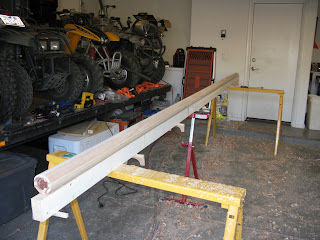This week I started shaping the mast. I actually started last Sunday afternoon but ended up giving up when I decided that the Bosch power plane that I had bought was not going to work. For some reason the engineers at Bosch decided to add several grooves on the front shoe of the plane that was not conducive to planing the mast since initially the mast is not a flat surface with the cedar staves sticking up higher than the poplar stave! So after trying it on one of the sides and seeing how it did an uneven job of planing I promptly gave up and put it back in the box so I could return it to Lowes. I ended up picking up a DeWalt plane which only has one grove in the front shoe that runs down the middle. The only bad thing bout the DeWalt is that it did not come with an adapter for the dust collector and also did not come with a handy little bag like the Bosch did so it makes a massive mess of the garage!
It definitely came in handy for cleaning up the big epoxy runs that squeezed out from the joints. Basically I used the power plane to clean up the majority of each surface and then came back with the number 5 hand plane to get it exact. I must admit that there is a certain Zen to using the hand plane that you don't get with power tools - although that being said there is also a certain Zen about not ramming into epoxy globs with the hand plane also!
Once I got all eight sides cleaned up I proceeded to start rounding the back side of the mast. The first step was to locate the center of each of the sides. The next step was to double the amount of faces to get the mast closer to round. Basically the idea is to go from 8 faces to 16 faces - or in this case from 5 faces to 10 (since I'm only doing half the mast). I figured out the offsets from the center line and drew in a set of offset lines. I then used these lines as guides to help me plane in the extra faces. Once the extra faces were planed in I then finished up with the hand plane and knocked off the ridges between each of the faces.
Next step was to build a boxed sander to start the sanding process (A nice little hint that I picked up from some on-line research). I ended up using some scrap poplar along with some wooden handles that where left over from another project that I have been storing in my garage for the past 7 years! I then spent some quality time with it and 80 grit sand paper that I loaded into it. Nice thing about the Cedar is that it is really easy to sand!
It did a passable job of getting the mast round without a whole lot of effort.
Next step is to round off the bottom part of the mast and then it's off to work on another one of the spars!
Sunday, May 22, 2011
Subscribe to:
Post Comments (Atom)






No comments:
Post a Comment